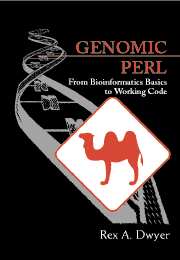Book contents
- Frontmatter
- Contents
- Preface
- Acknowledgments
- 1 The Central Dogma
- 2 RNA Secondary Structure
- 3 Comparing DNA Sequences
- 4 Predicting Species: Statistical Models
- 5 Substitution Matrices for Amino Acids
- 6 Sequence Databases
- 7 Local Alignment and the BLAST Heuristic
- 8 Statistics of BLAST Database Searches
- 9 Multiple Sequence Alignment I
- 10 Multiple Sequence Alignment II
- 11 Phylogeny Reconstruction
- 12 Protein Motifs and PROSITE
- 13 Fragment Assembly
- 14 Coding Sequence Prediction with Dicodons
- 15 Satellite Identification
- 16 Restriction Mapping
- 17 Rearranging Genomes: Gates and Hurdles
- A Drawing RNA Cloverleaves
- B Space-Saving Strategies for Alignment
- C A Data Structure for Disjoint Sets
- D Suggestions for Further Reading
- Bibliography
- Index
16 - Restriction Mapping
Published online by Cambridge University Press: 05 June 2012
- Frontmatter
- Contents
- Preface
- Acknowledgments
- 1 The Central Dogma
- 2 RNA Secondary Structure
- 3 Comparing DNA Sequences
- 4 Predicting Species: Statistical Models
- 5 Substitution Matrices for Amino Acids
- 6 Sequence Databases
- 7 Local Alignment and the BLAST Heuristic
- 8 Statistics of BLAST Database Searches
- 9 Multiple Sequence Alignment I
- 10 Multiple Sequence Alignment II
- 11 Phylogeny Reconstruction
- 12 Protein Motifs and PROSITE
- 13 Fragment Assembly
- 14 Coding Sequence Prediction with Dicodons
- 15 Satellite Identification
- 16 Restriction Mapping
- 17 Rearranging Genomes: Gates and Hurdles
- A Drawing RNA Cloverleaves
- B Space-Saving Strategies for Alignment
- C A Data Structure for Disjoint Sets
- D Suggestions for Further Reading
- Bibliography
- Index
Summary
One of the ways biologists begin to analyze a long sequence of DNA is to develop a restriction site map. Restriction sites are the locations at which the sequence is cut by enzymes known as restriction enzymes – or, more precisely, restriction endonucleases. Restriction enzymes are found in bacteria, where they provide some protection against viral invasion by destroying viral DNA. Each bears a name such as EcoRI and HindIV, derived from the bacterium in which it was discovered. Each restriction enzyme can cut DNA at any location containing a specific short sequence. Examples of some commonly used restriction enzymes and the sequences they cut are given in Figure 16.1. The sequence is typically a palindrome of even length. In most cases, the enzyme cuts the double strand unevenly so that a small group of unpaired nucleotides – a sticky end – remains on both sides of the cut. In nature, this feature may facilitate further degradation of the invading DNA by other enzymes; in the laboratory, it is often used to “cut and paste” new sequences into DNA at known locations.
A restriction map of a sequence is simply a list of the locations at which one or more restriction enzymes are known to cut the sequence. Such a map can be used to pinpoint the origin of a gene or other subsequence within a larger sequence.
Restriction maps are generally constructed by performing digestion experiments: The sequence to be mapped is replicated by PCR and then exposed to one or more restriction enzymes, together and/or separately.
- Type
- Chapter
- Information
- Genomic PerlFrom Bioinformatics Basics to Working Code, pp. 257 - 274Publisher: Cambridge University PressPrint publication year: 2002



